An intensive, one-day roundtable convened May 30 in Toronto by Carleton University’s journalism program saw some of the world’s leading experts on the intersection of journalism and artificial intelligence voice a clear message to the news industry and its workforce: while human ingenuity and a professional passion for storytelling and stirring democratic debate will always drive the journalistic enterprise, incorporating AI tools in newsrooms could liberate reporters and editors from mundane, repetitive tasks, lend the immense sorting and computational power of AI to the vital data analysis and investigative functions of journalism, and boost struggling news organizations’ financial fortunes with AI-assisted production, packaging and distribution of content.
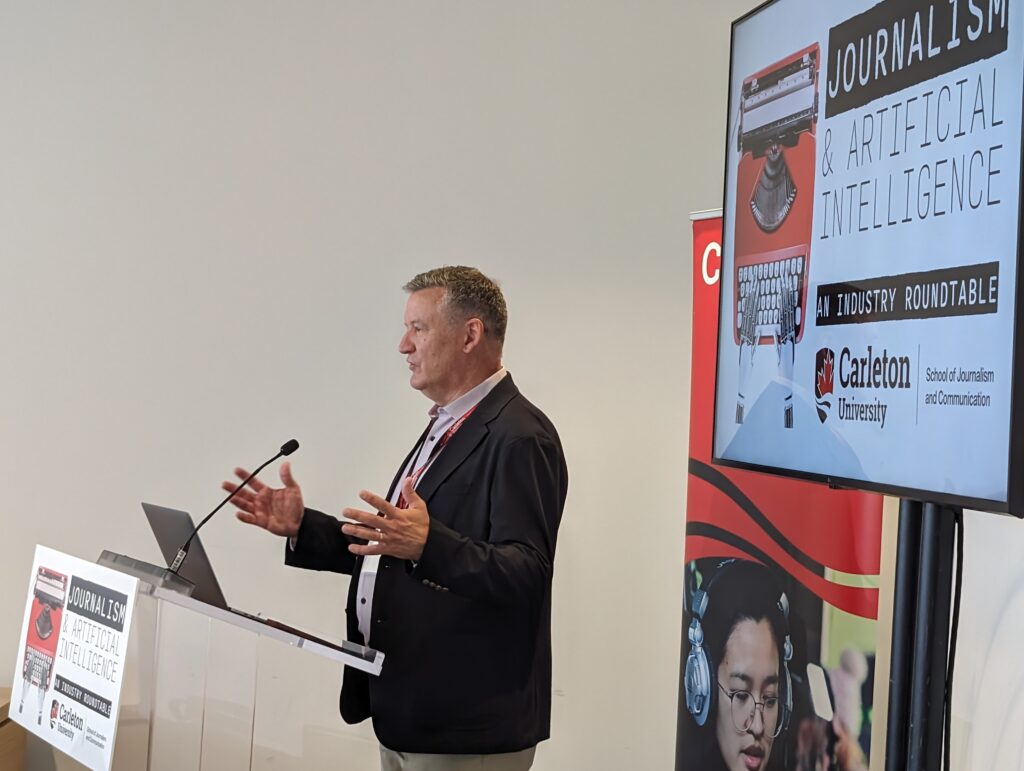
“Journalism and Artificial Intelligence: An Industry Roundtable,” part of an international knowledge exchange and mobilization project initiated by Carleton’s journalism program, was held in conjunction with the May 31-June 2 annual meeting of the Canadian Association of Journalists.
The CAJ partnered on the Carleton-led roundtable with the Polis/London School of Economics JournalismAI Project, journalist Nikita Roy’s “Newsroom Robots” podcast and the Globe and Mail, which provided meeting space for the event at its downtown Toronto headquarters. The roundtable was funded by a grant from the Social Sciences and Humanities Research Council of Canada.

“Our goal is to both establish and engage with a global network of experts, and to examine the nexus between journalism and AI in order to find lessons for journalism practice and education,” said roundtable organizer Prof. Allan Thompson, director of Carleton’s School of Journalism and Communication and head of its journalism program.
“As our partner the JournalismAI Project has noted, as journalism continues to suffer from the decline of traditional business models, news leaders are increasingly pressured to shift toward data-driven logics,” said Thompson. “Many news organizations are now hopeful investments in AI technology could generate additional revenue and make better use of the time and creative labour of working journalists and editors.”
However, Thompson acknowledged that “some journalists fear being replaced by AI, and there are frictions between traditional journalism values and ethics and the values inherent in AI systems.”
In his opening remarks on Thursday, Thompson invited participants to share their views about “the good, the bad and the ugly” as they assess the journalistic landscape in the AI era — opportunities and optimism as well as concerns and fears about the potential impacts of this powerful technology.
“I think we all feel it in our bones that we are at a pivot point in the journalism industry,” said Thompson. “The existential crisis of collapsing business models is now compounded by the challenges and opportunities presented by artificial intelligence.”

“We don’t know much yet about the potential impact of AI on the news itself and the health of our public discourse,” Thompson stated ahead of the roundtable. Rather than providing a salvation, we must consider that AI could risk making news organizations even more reliant on technology and the companies that dominate AI development, and irreversibly alter the media ecosystem in negative ways.”
‘Many news organizations are now hopeful investments in AI technology could generate additional revenue and make better use of the time and creative labour of working journalists and editors.’
— Prof. Allan Thompson, roundtable organizer and director of Carleton’s journalism school
Proceedings Playlist
A global conversation has been unfolding in recent years as journalists, researchers and industry executives try to gauge the promise and potential pitfalls of AI for the profession and the news business. For example, the recent International Festival of Journalism, held in Perugia, Italy from April 17-21, featured about 20 panel discussions examining the opportunities and challenges facing journalism in the era of generative AI.
From concerns about high-calibre deepfakes polluting the public discourse to excitement around time-saving — and audience-building — AI-assisted news production and distribution tools, the range of possible impacts of AI on journalism seems to be expanding daily.
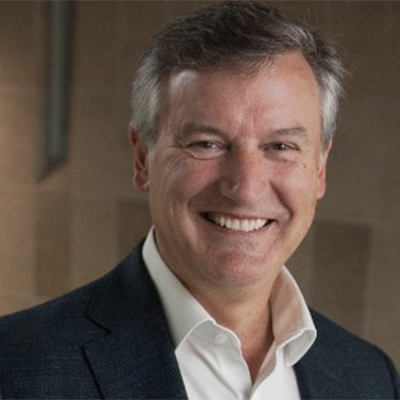
The general public may have heard about newscast avatars or the AI-related controversy that engulfed Sports Illustrated last year, in which Advon Commerce — a third-party content-creation partner of the venerable sports publication — used fake names, fake bios and AI-generated images of “authors” of certain features under the SI online banner, such as a primer on volleyball by a non-existent writer named Drew Ortiz. (The scandal was exposed by real-life journalist Maggie Harrison Dupré, a New York-based tech writer with Futurism.)
Meanwhile, with relatively little public attention, a multitude of AI tools and tasks — to generate potential headlines for busy editors, to quickly replicate story teasers for social platforms, to rapidly scan massive datasets or voluminous documents for wheat-from-chaff story ideas — have been incorporated into the content production and distribution processes of many news organizations.
And individual reporters have been using fairly rudimentary transcription assistants, such as otter.ai, to rapidly produce close-to-accurate text records of interviews that can be easily vetted and edited for precision.
At the same time, what’s genuinely useful, what’s potentially transformative, what’s ethically worrisome and what’s reputationally risky when it comes to AI-assisted journalism remains subject to much discussion and debate.
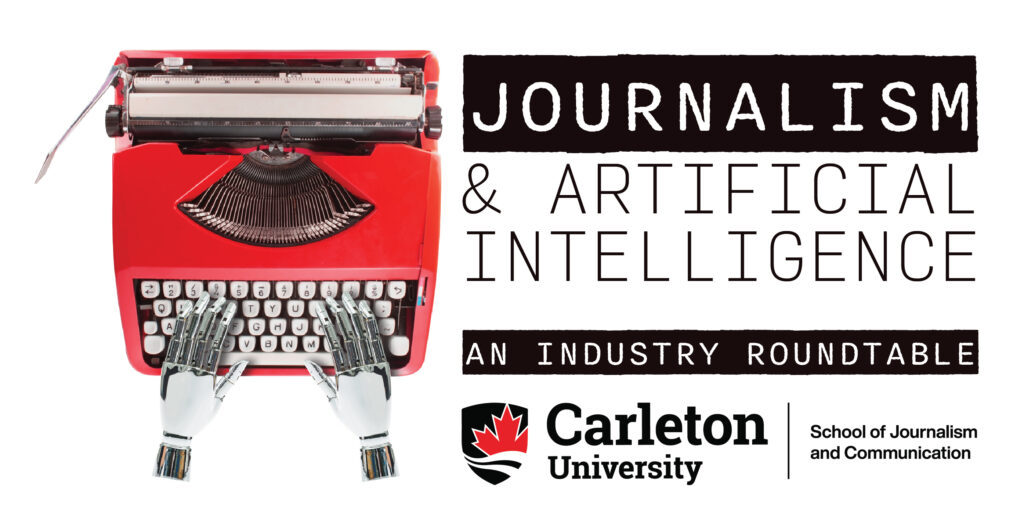
Among those participating in Thursday’s roundtable was Canadian journalist and educator Nikita Roy, whose year-old “Newsroom Robots” podcast has become an indispensable forum for tracking and analyzing the integration of AI in newsrooms, including consideration of the ethical guardrails needed to ensure transparency, accuracy and other professional standards. Roy, who also leads the AI Journalism Lab at the Craig Newmark Graduate School of Journalism at the City University of New York, headed a roundtable-opening workshop on the fundamental features of journalism and AI.
Roy kicked off the main proceedings with a primer on how artificial intelligence is being used by journalists — including herself — to save time, create better content, package and distribute it more effectively. She listed 20 specific ways AI can be used to help journalists do their work, including brainstorming ideas and interview questions, serving as a “second set of eyes” to create alt-text photo descriptions and perform a wide range of other tasks.

At one point in her presentation, she showed two video images of herself, one of which was AI-generated, and asked the audience to choose which one was the real Nikita. In this case, considerably more people picked the AI version, which she said is common. [Photo © Angel Xing]
Roy said she’s had several revelatory moments when an AI tool offered such remarkable advantages she found herself “blown away.” She highlighted the chore of data analysis, and how quickly AI could interpret massive amounts of information “in a matter of minutes. That’s when my jaw dropped.”
When the ChatGPT 4.0 demo was released, said Roy, she was “like a kid on Christmas day.” The advances were “revolutionary,” she said. “It’s been advancing so quickly.”
The roundtable’s keynote speaker was Prof. Charlie Beckett, founding director of Polis, the U.K. think-tank for research and debate around international journalism and society in the Department of Media and Communications at the London School of Economics and Political Science. Beckett heads the Polis JournalismAI project and is the author of a landmark 2019 report — New powers, New responsibilities: A global survey of journalism and artificial intelligence — that began with a powerful distillation of this moment in journalism history: “No, the robots are not going to take over journalism. Yes, the machines might soon be able to do much routine journalism labour. But the reality and the potential of artificial intelligence (AI), machine learning, and data processing is to give journalists new powers of discovery, creation and connection.”
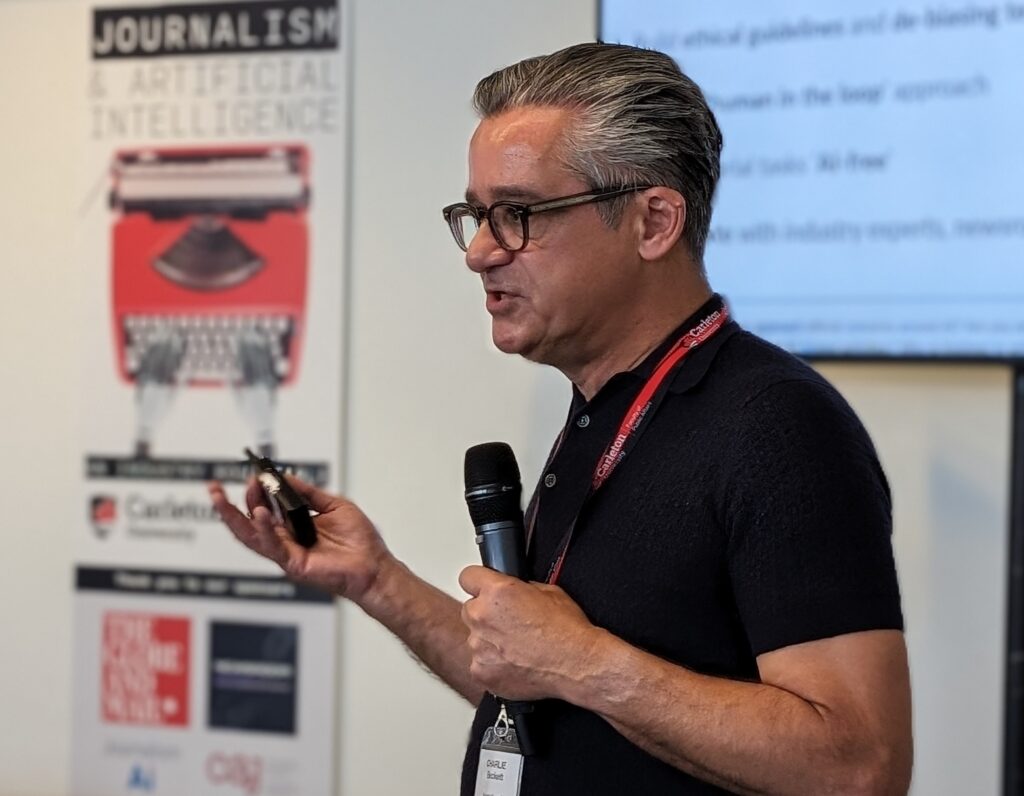
In his keynote address, Beckett acknowledged there are technical, ethical and organizational challenges facing journalists as they attempt to utilize AI tools to enhance newsgathering, story packaging and audience reach. But the obstacles, he noted, are being overcome in many newsrooms and the potential benefits of integrating AI’s capabilities into news work are innumerable.
“AI is a really useful tool, but it’s also perhaps changing the way you do your journalism, and giving you new capacity,” he said — quickly adding that there are “lots of challenges.” These include managing resistance to change within newsrooms — “my boss isn’t on board” — and overcoming a kind of disruption fatigue that has set in after so many economic and technological upheavals in journalistic workplaces.
“People have been through a lot of changes over the last 10-15 years, and I think a lot of journalists are just thinking: ‘Oh my God, here we go again.” Meanwhile, he added, some journalists see AI technology as “the devil’s work” and don’t want to touch it.
But, the potential benefits are enormous, he said. “It’s really important that we have everyone from every aspect of news production right through to news distribution thinking about this and being part of an effort to integrate it into their news organizations.”

Given AI’s immense capabilities, he added: “If you want to retain your place in the infosphere, then you’ve got to start using it.”
He explained ways to use AI ethically, such as having industry standards, reinforcing journalism and AI training, and collaborating with other newsrooms facing the same issues.
The May 30 roundtable on journalism and AI flows well from an October 2020 conference also hosted by Carleton’s journalism program — Journalism in a Time of Crisis — that explored the implications of the traditional news industry’s financial collapse and the acceleration of problems during the COVID-19 pandemic, but also the growing importance of credible, sustainable, professional journalism in an era of misinformation and disinformation.

As the Reuters Institute for the Study of Journalism noted in its most recent report on media and technology trends, the disruptive power of AI is expected to “sweep through the information space this year at a time of intense political and economic volatility around the world.” As the report notes, the implications for the reliability of information and the sustainability of the mainstream media are profound.
Against that background, journalists and news organizations will need to rethink their role and purpose with some urgency. U.S. journalist Louise Story, an AI consultant and former Wall Street Journal AI specialist — and one of the roundtable panelists — has written about the urgent need to figure out which aspects of AI technology journalists must use in the service of impactful journalism and audience engagement.
“AI will reshape the media landscape, and the organizations who use it creatively and impactfully will thrive,” Story argues.
At the roundtable event, Story was joined in a panel discussion on how newsrooms are already using AI by Nafid Ahmed, vice-president of enterprise analytics, data science and consumer insights at The Globe and Mail; Anita Li, Toronto-based publisher of The Green Line; and Troy Thibodeaux, director of AI products and services with the Associated Press. The panel was chaired by Carleton University instructor and CBC broadcaster Kate Porter.
The second panel discussion of the day focused on the challenge that AI tools pose to journalism ethics and the need for news organizations to create guidelines for utilizing AI in newsgathering, content production and news distribution.
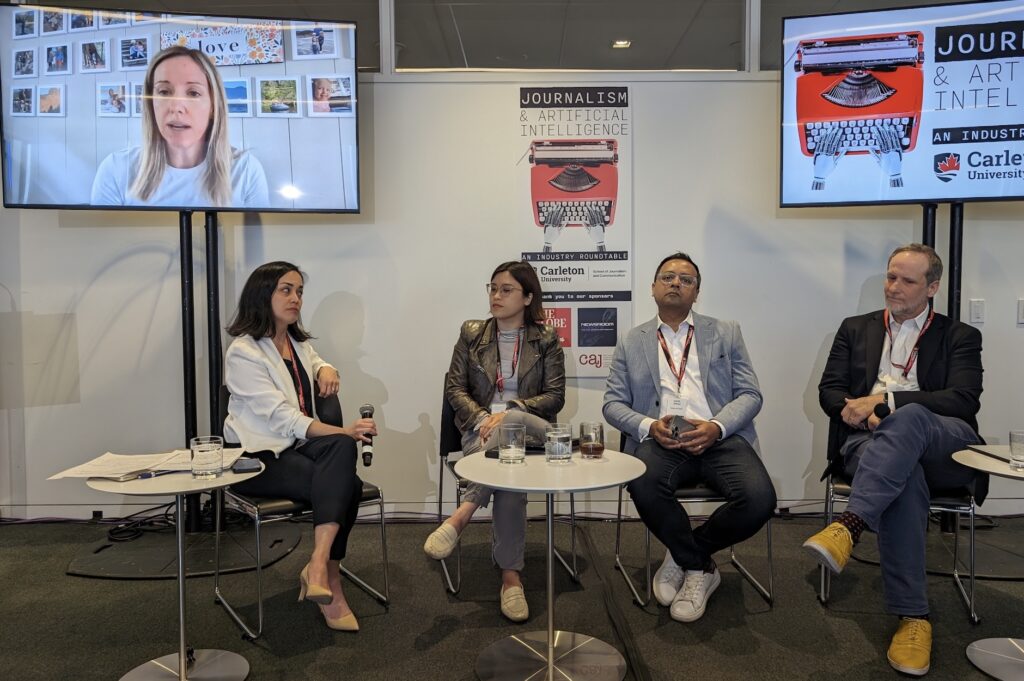
That session was chaired by Carleton University associate professor Aneurin Bosley, who teaches multimedia journalism and digital media ethics in the School of Journalism and Communication. The conversation included Gina Chua, executive editor of the digital news outlet Semafor, formerly a senior executive with Reuters and Wall Street Journal Asia, who attended virtually from Singapore. The other panelists were Florent Daudens of the AI innovation firm Hugging Face — who is also a journalism lecturer at the Université de Montréal and was formerly head of AI initiatives at Radio-Canada — and Chris Dinn, an Emmy-award-winning AI innovator who created Torontoverse, a digital local news outlet.
The panelists pushed back against what they called unfounded fears and misconceptions about the use of artificial intelligence in journalism, but emphasized that the integration of AI tools in newsrooms should be governed by guidelines that help journalists avoid the misuse of the technology and ethical pitfalls.
The day’s final panel discussion focused on the challenge of teaching AI skills in both classrooms and newsrooms. Chaired by broadcaster and Carleton University instructor Caroline O’Neill, the panel included three educators at the forefront of introducing AI skills training to both working professionals and aspiring journalists in postsecondary programs: Jeremy Caplan, director of teaching and learning at the Craig Newmark Graduate School of Journalism at City University of New York; Daudens, who discussed his work at Université de Montreal as well as the drafting of guidelines on AI use in his former senior position at Radio-Canada; and Mario Garcia, an author and instructor in multimedia storytelling and AI at Columbia Journalism School.
‘It’s really important that we have everyone from every aspect of news production right through to news distribution thinking about this and being part of an effort to integrate it into their news organizations.’
— Prof. Charlie Beckett, roundtable keynote speaker and head of Polis/LSE JournalismAI project
In his presentation, Garcia emphasized how important it is for journalists to develop “prompt engineering” skills — the ability to effectively direct AI programs to yield high-quality, accurate, illuminating information shaped and vetted by creative human minds.
Garcia flashed an excerpt from his latest book — AI: The Next Revolution for Content Creation — on the screen to underscore the message that AI tools should be seen as working in the service of journalists’ storytelling prowess and imaginations.
“While AI excels at tasks like data analysis and pattern recognition,” the excerpt from Garcia’s book reads, “it often struggles with generating truly imaginative ideas. More importantly, AI connects patterns, but humans make connections between seemingly unrelated concepts or ideas. Human creativity is not just about processing information — it’s about imagination, intuition, and the ability to see possibilities where others might see limitations.”
“It’s not enough to have one unit on AI over the course of a semester,” noted O’Neill, who teaches in the Media Production and Design program at Carleton’s journalism school, ahead of the roundtable event. “How can educators thoughtfully weave AI into their curriculum? And how early should AI be brought into core journalism courses? These are some of the questions we will be exploring.”
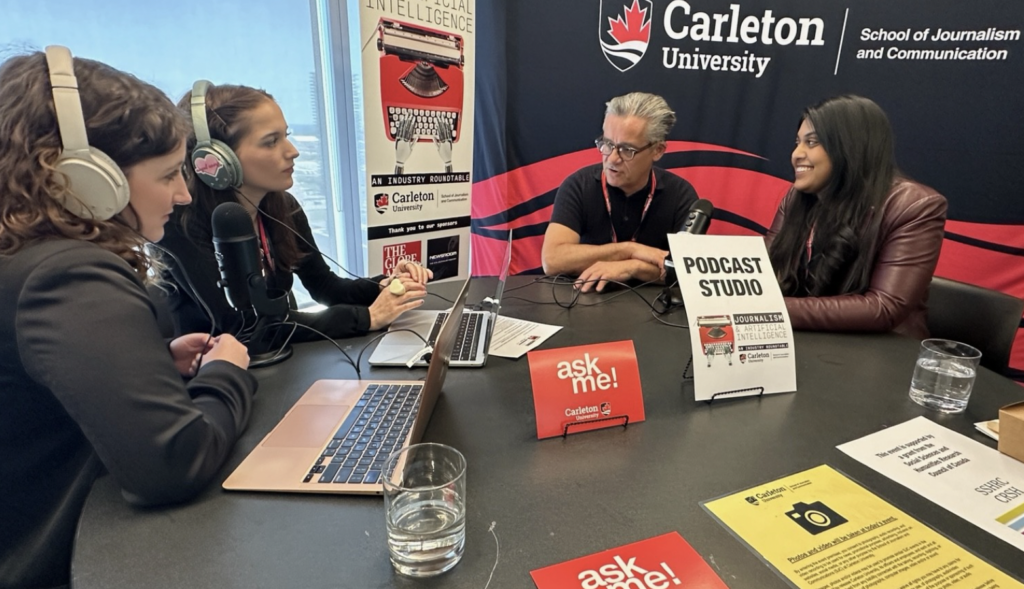
O’Neill insisted that newsrooms “can’t afford to be complacent when it comes to AI” at a time when collapsed revenues and massive job losses have forced an industry-wide reckoning and restructuring. “We need to have serious conversations about how AI can be used to the benefit of under-resourced newsrooms while protecting jobs in those newsrooms.”
Following the third panel discussion, Thompson and O’Neill facilitated a final, hour-long brainstorming session involving all panelists and audience members — which included representatives from a wide range of Canadian media outlets, many in Toronto for the annual CAJ conference — to summarize the roundtable highlights and set priorities for guiding the adoption of AI tools in newsrooms.
Among those in attendance were CAJ president Brent Jolly, Toronto Metropolitan University professor April Lindgren — a leading Canadian researcher on the existential challenges facing local news outlets — and Carleton journalism professor and former CBC broadcaster Nana aba Duncan, Carty Chair in Journalism, Diversity and Inclusion Studies.
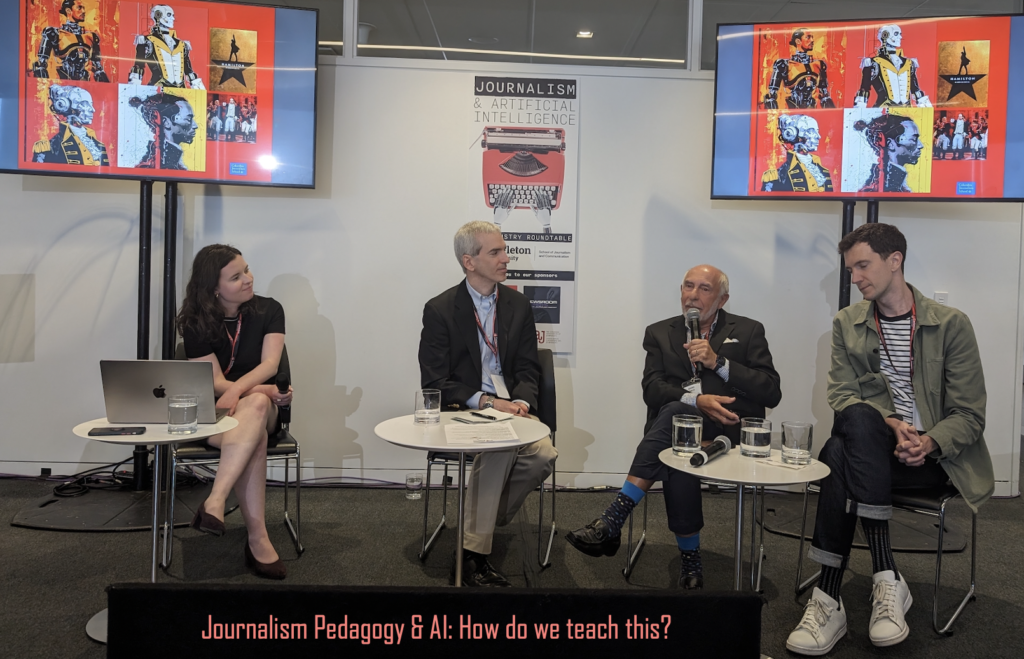
Seizing upon the active discussion about the impact of AI during what most regard as an ongoing crisis in the journalism industry, the main goal of the roundtable was to identify the risks and possibilities presented by artificial intelligence tools, how those tools are already shaping journalism and how best and most ethically to absorb and apply the lessons learned both within news organizations and in the journalism classroom.
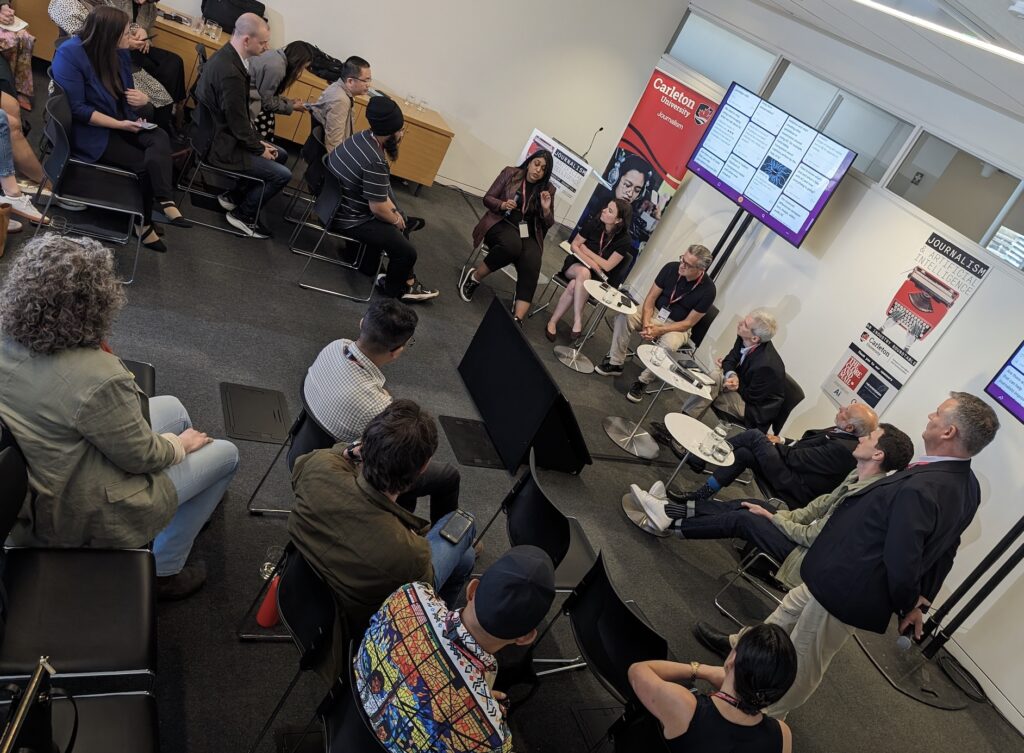
Carleton’s journalism school, the oldest in Canada, was founded in October 1945 in the wake of the Second World War and, in some measure, was created in response to the cataclysm of that conflict and the desire to foster journalism as a cornerstone of our democracy. As the school approaches its 80th birthday, Thursday’s gathering of leading scholars and experts, working journalists and journalism educators and students confronted what some have described as a major technological innovation on the scale of the industrial revolution.